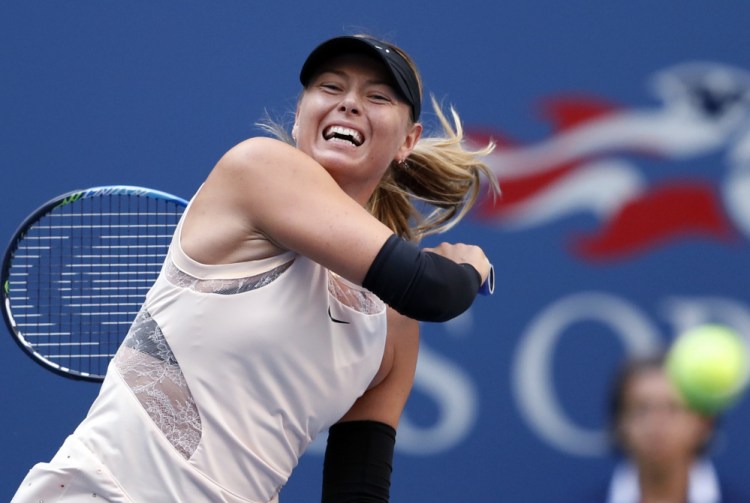NEW YORK — No one, not even Maria Sharapova herself, knew quite what to expect from her return to Grand Slam tennis at the U.S. Open.
It had been 19 months since she had entered a major tournament. She played only nine times anywhere since a 15-month doping suspension ended in April. Two three-set tussles into her stay at Flushing Meadows, it’s clear that Sharapova’s game might be patchy, but she is as capable as ever of coming up with big strokes in big moments – and maybe, just maybe, could stick around for a while in a depleted draw.
Sharapova became the first woman to reach the third round at the U.S. Open by using 12 aces to help set aside a poor start and beat Timea Babos of Hungary 6-7 (4), 6-4, 6-1 on Wednesday in Arthur Ashe Stadium.
“Look, I certainly have expectations, just because I know I’ve been in these stages before and I’ve been able to execute. There’s a certain level of ‘I know I can do this. I’ve done it before. I want to have that feeling again,'” Sharapova said. “But there’s also the realistic understanding of, ‘OK, you haven’t been in this situation for a while. It’s going to take a little time.’ Of course, managing expectations is part of it, learning as you play the matches, which is something I haven’t done for a long time.”
Her victory was the highlight of a busy day that featured 87 singles matches on the schedule after rain washed out most play a day earlier. With so many matches going on, there were plenty of names to keep tabs on, although few truly remarkable results.
The most noteworthy second-round loss was by No. 4 Alexander Zverev, a 20-year-old German who, despite his lofty seeding and considerable potential, has only once been as far as the fourth round at a major. He was beaten by Borna Coric 3-6, 7-5, 7-6 (1), 7-6 (4).
Past U.S. Open champions who advanced included Venus Williams and Marin Cilic into the third round, and Juan Martin del Potro and Svetlana Kuznetsova – who saved three match points – into the second. No. 14 Nick Kyrgios, No. 22 Fabio Fognini, No. 26 Richard Gasquet and No. 27 Pablo Cuevas all lost their openers.
In the early going, it looked as if Sharapova might join them on the way out.
She made 19 unforced errors in the first set, which ended with her missing twice on forehands to give the 59th-ranked Babos the lead. But as the match went on, Sharapova looked more and more like someone who used to be ranked No. 1 and owns five major titles – including the 2006 U.S. Open – than someone who needed a wild-card invitation from the U.S. Tennis Association because she is now 146th, on account of her ban and lack of play.
Sharapova last participated in a major tournament at the 2016 Australian Open, where she tested positive for the newly banned heart drug meldonium. She declined to answer a reporter’s question about how frequently she’s been drug-tested this year.
Babos said she thought it was “a little bit unfair for the other players” that Sharapova got into the field, a sentiment echoed by No. 20 seed CoCo Vandeweghe of the U.S., who would have preferred that an American get that wild card.
But here Sharapova is, and she does not appear ready to be an easy out.
“Towards the end of the second set, I felt like I was the fresher player. Going into a third set, that’s a good position or a good feeling to have,” said the 30-year-old Russian, who wore a strip of black tape on the left forearm that bothered her earlier in the month.
She also had a sleeve on her right elbow, which she said was to keep that arm warm.
Sharapova cut down her miscues to 12 unforced errors in the second set, then just five in the third, and finished with a 39-13 advantage in winners, looking as strong as she did while eliminating No. 2 seed Simona Halep in a three-set thriller Monday.
“I definitely wanted to enjoy the quality of tennis that I played with the other night,” Sharapova said, “but I also wanted to put my mind onto this one.”
Sharapova’s serving made a difference down the stretch against Babos: She won 16 of the last 19 points she served.
“In key moments, she showed why, no matter what happened to her, why she is a big player and good player,” Babos said, “because she came up with some very, very good shots and she didn’t miss her opportunities.”
Send questions/comments to the editors.



Comments are no longer available on this story